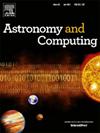Hoyle-Narlikar引力理论的宇宙学含义和约束
IF 1.8
4区 物理与天体物理
Q2 ASTRONOMY & ASTROPHYSICS
引用次数: 0
摘要
我们讨论了Hoyle-Narlikar创造场理论中的一些宇宙学含义和限制,以解释宇宙膨胀的宇宙演化。为了得到修正场方程的解析解,我们使用创建场C(t)=t+∫1a2+c1,t+∫1a+c2,t+∫1a+c3的具体选择,得到模型I, II和III三种选择。对于尘埃流体的背景源,我们找到了每个模型的哈勃函数,然后通过结合CC和Pantheon数据集的1σ和2σ置信水平的检查,获得了模型参数H0和Ωm0的值。利用这些模型参数的值,我们测量了衍生参数的值,并通过给出宇宙学参数的几何行为来讨论结果。我们将三个模型并列讨论,并利用状态参数ωeff、减速参数q(z)的有效方程和Om诊断分析对它们进行比较,将模型划分为不同的演化阶段。我们还讨论了目前宇宙的年龄。本文章由计算机程序翻译,如有差异,请以英文原文为准。
Cosmological implications and constraints in Hoyle–Narlikar gravity theory
We discuss some cosmological implications and constraints in Hoyle–Narlikar’s creation field theory to explain the cosmic evolution of the expanding universe. To obtain an analytical solution of the modified field equations, we use the specific choices of the creation field and get three alternatives as Model I, II, and III. For the background source of dust fluid, we find the Hubble function for each model and subsequently obtain values for the model parameters and by combining the examination of the CC and Pantheon datasets with and confidence levels. Using these values of model parameters, we measure the values of derived parameters and discuss the results by presenting the geometrical behavior of cosmological parameters. We talk about three models side by side and compare them using the effective equation of state parameter , the deceleration parameter , and Om diagnostic analysis to group the models into stages of evolution. We also discuss the present age of the universe.
求助全文
通过发布文献求助,成功后即可免费获取论文全文。
去求助
来源期刊

Astronomy and Computing
ASTRONOMY & ASTROPHYSICSCOMPUTER SCIENCE,-COMPUTER SCIENCE, INTERDISCIPLINARY APPLICATIONS
CiteScore
4.10
自引率
8.00%
发文量
67
期刊介绍:
Astronomy and Computing is a peer-reviewed journal that focuses on the broad area between astronomy, computer science and information technology. The journal aims to publish the work of scientists and (software) engineers in all aspects of astronomical computing, including the collection, analysis, reduction, visualisation, preservation and dissemination of data, and the development of astronomical software and simulations. The journal covers applications for academic computer science techniques to astronomy, as well as novel applications of information technologies within astronomy.
 求助内容:
求助内容: 应助结果提醒方式:
应助结果提醒方式:


